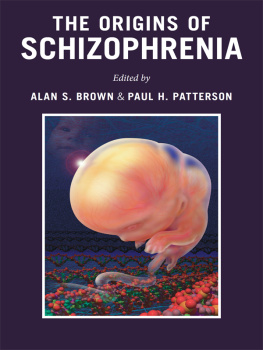Brown Alan S. - The Origins of Schizophrenia
Here you can read online Brown Alan S. - The Origins of Schizophrenia full text of the book (entire story) in english for free. Download pdf and epub, get meaning, cover and reviews about this ebook. City: New York, year: 2015;2011, publisher: Columbia University Press, genre: Romance novel. Description of the work, (preface) as well as reviews are available. Best literature library LitArk.com created for fans of good reading and offers a wide selection of genres:
Romance novel
Science fiction
Adventure
Detective
Science
History
Home and family
Prose
Art
Politics
Computer
Non-fiction
Religion
Business
Children
Humor
Choose a favorite category and find really read worthwhile books. Enjoy immersion in the world of imagination, feel the emotions of the characters or learn something new for yourself, make an fascinating discovery.
- Book:The Origins of Schizophrenia
- Author:
- Publisher:Columbia University Press
- Genre:
- Year:2015;2011
- City:New York
- Rating:3 / 5
- Favourites:Add to favourites
- Your mark:
- 60
- 1
- 2
- 3
- 4
- 5
The Origins of Schizophrenia: summary, description and annotation
We offer to read an annotation, description, summary or preface (depends on what the author of the book "The Origins of Schizophrenia" wrote himself). If you haven't found the necessary information about the book — write in the comments, we will try to find it.
The Origins of Schizophrenia — read online for free the complete book (whole text) full work
Below is the text of the book, divided by pages. System saving the place of the last page read, allows you to conveniently read the book "The Origins of Schizophrenia" online for free, without having to search again every time where you left off. Put a bookmark, and you can go to the page where you finished reading at any time.
Font size:
Interval:
Bookmark:
THE ORIGINS OF SCHIZOPHRENIA
THE ORIGINS OF SCHIZOPHRENIA
EDITED BY
Alan S. Brown, M.D., M.P.H.
Professor of Clinical Psychiatry and Clinical Epidemiology
Columbia University College of Physicians and Surgeons
Paul H. Patterson, Ph.D.
Anne P. and Benjamin F. Biaggini Professor of Biological Sciences
California Institute of Technology
COLUMBIA UNIVERSITY PRESS New York 
Columbia University Press
Publishers Since 1893
New York Chichester, West Sussex
cup.columbia.edu
Copyright 2012 Columbia University Press
All rights reserved
E-ISBN 978-0-231-52192-5
Library of Congress Cataloging-in-Publication Data
The origins of schizophrenia / edited by Alan S. Brown and Paul H. Patterson.
p. ; cm.
Includes bibliographical references and index.
ISBN 978-0-231-15124-5 (cloth : alk. paper)ISBN 978-0-231-52192-5 (e-book)
1. SchizophreniaEtiology. I. Brown, Alan S., M.D. II. Patterson, Paul H.
[DNLM: 1. Schizophreniaetiology. WM 203]
RC514.O755 2012
616.89'8071dc22 2011012628
A Columbia University Press E-book.
CUP would be pleased to hear about your reading experience with this e-book at .
References to Internet Web sites (URLs) were accurate at the time of writing. Neither the editors nor Columbia University Press is responsible for URLs that may have expired or changed since the manuscript was prepared.
To Anne and Skyler for their support, patience, and understanding through the long days and late nights
A.S.B.
To Carolyn for her enthusiastic support in all of these efforts.
P.H.P.
I know the editors of this important volume, Alan Brown and Paul Patterson, well enough to have a glimmer of insight into how they came together to lead this book. They are both tenacious iconoclasts who have doggedly championed the hypothesis of maternal infection as a risk factor for schizophrenia while the rest of their peers were chasing dopamine and genes. The answer that they arrived at independently, Alan Brown from his tireless and creative work in epidemiology and Paul Patterson from his creative approaches in animal neurobiology, is quite striking because it was entirely unexpected. It is not the infection per se, but rather the reaction of the mothers body to it that seems to affect the fetal development of an individual who only much later in life will become ill with schizophrenia as he or she approaches adulthood. This remarkable story, with converging evidence from two different disciplines, is the cornerstone of the book. It sets the stage for understanding a range of influences on the risk for schizophreniagenetic variants in the major histocompatability loci, obstetrical complications, and maternal psychological and social stress. All these factors can cause the mother to mount an immune response on the baby or at least its part of the placenta. The effects on fetal development, although subtle, can have ominous consequences. The title, The Origins of Schizophrenia, is therefore bold and perhaps off-putting, but the book delivers on its promise.
Furthermore, the book delivers in an exciting and provocative way. Clinical chapters are matched hand in hand with neurobiological models in animals for an astonishing diversity of possible causal factors. As I read each human chapter, I found myself mumbling to the potential animal modeler, model this! And yet, there it was: not a promise that there would someday be an animal model, but meaningful research that actually provides the possible if not probable mechanism for an observation in the human population. Of course, Paul Pattersons own work on maternal immune activation as a model for the effects of maternal infection is a prime example.
The book might have begun with the story of how the two of them came together, I suspect at a meeting somewhere when a translational panel was considered. I began to wonder who the other two speakers might have been, if it was the traditional panel of four; who might have organized or chaired it; and if many people were in the audience, or if the panel was held during the last afternoon of the meeting, reserved for the miscellany while the themes currently in vogue grabbed the limelight on the first day.
Why did they do it, and why did they decide to broaden the book beyond their own area of mutual interest? They allude to the reasons in their own introduction. The message, unspoken except in their brief introduction, is that clinical research has advanced to the point to ask many meaningful questions about the pathological mechanisms that cause schizophrenia, and animal neurobiology has responded with answers. These answers carry with them the possibility of new treatments, including new preventive treatment that should begin as early as conception.
This book is a milestone, but I hope that a book on epidemiology and animal models of the relevant mechanisms can be followed soon by a companion book on treatments developed using these animal models and their application to the treatment and ultimately the prevention of schizophrenia in humans. That would indeed be a worthy conclusion to the pioneering efforts of Alan Brown and Paul Patterson and the distinguished cast of contributors who have authored this important volume.
Robert Freedman, M.D.
University of Colorado School of Medicine
Editor-in-Chief, American Journal of Psychiatry
Denver, Colorado
In addition to the people and sources of support acknowledged in the dedication and the individual chapters, we are indebted to several individuals who helped make this book possible. First, we wish to thank Patrick Fitzgerald of Columbia University Press for his foresight and unwavering support during the writing, editing, and compilation process. Second, we express our gratitude to Patric Prado, Nicole Stephenson, Jacky Chow, John Donohue, and Bridget Flannery-McCoy for their valuable technical efforts. Finally, we thank all of the individuals who selflessly offered their time as participants in the research studies described herein.
This book was motivated by recent evidence that the origins of schizophrenia almost certainly encompass both environmental and genetic factors, which, through both independent and interactive neurodevelopmental mechanisms, appear to play important roles in this disorder. This theory is based on support from several domains of research. First, many new findings on potential environmental etiologies have emerged from epidemiologic studies. These investigations feature fundamental methodologic improvements over prior work, including birth cohort and other longitudinal approaches, prospective and more precise definitions of exposure status, control of confounding, and addressing bias due to attrition. These developments have markedly improved the validity and interpretability of this body of research and suggest potential novel preventive approaches. Second, rapid advances in molecular genetic and genomic approaches, including genomewide association studies, and the emerging fields of copy number variation and epigenetics, as well as new statistical methods and bioinformatic strategies, have markedly expanded the power to decipher the genetic variants and modifications that may alter brain development and contribute to susceptibility for schizophrenia. Third, a revolution in preclinical, translational models of schizophrenia has allowed the testing of several environmental and genetic candidates of these disorders, particularly those that act to modify neurodevelopmental processes. This has facilitated validation of clinical findings, enhanced the understanding of etiopathogenic mechanisms, and revealed potential treatment approaches that target the aberrant processes that are triggered by these insults. The reach of these studies has been further enhanced by improvements in behavioral assays, gene expression profiling, laser microdissectionreal time polymerase chain reaction, and small-animal magnetic resonance imaging technologies. Finally, further developments in research on the biological basis of schizophrenia have yielded astounding insights into the neurodevelopmental and pathophysiologic basis of schizophrenia. These discoveries are having profound effects on epidemiologic, genetic, and translational approaches to schizophrenia, including the identification of candidate risk factors, the relevant functional effects of putative susceptibility genes, and the molecules, cellular pathways, and neurocircuits to be investigated in preclinical models. Several of these points are further elucidated by John Waddington in the Overview to this book.
Next pageFont size:
Interval:
Bookmark:
Similar books «The Origins of Schizophrenia»
Look at similar books to The Origins of Schizophrenia. We have selected literature similar in name and meaning in the hope of providing readers with more options to find new, interesting, not yet read works.
Discussion, reviews of the book The Origins of Schizophrenia and just readers' own opinions. Leave your comments, write what you think about the work, its meaning or the main characters. Specify what exactly you liked and what you didn't like, and why you think so.











